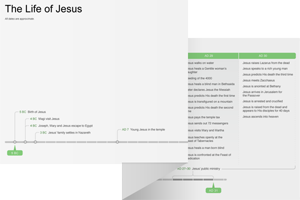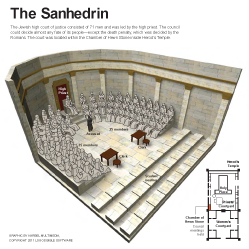7:1–5 The doubt over Jesus’ identity and teachings extended even to His own family, who apparently mistook Him for a fame-seeking miracle worker (compare John 6:42, 60–66). |
7:1 after these things The events of ch. 6 had taken place around Passover, a spring holiday. See note on 5:1.
Jews were seeking to kill him Jesus had upset the religious authorities by healing a man on the Sabbath (see vv. 23; 5:16–18; compare note on 1:19).
7:2 feast of Tabernacles One of the three pilgrimage festivals when Jews were to travel to Jerusalem if possible. See Lev 23:33–44 and note.
when Jews were to travel to Jerusalem if possible. See Lev 23:33–44 and note.
 Israelite Festivals Table
Israelite Festivals Table
Israelite Feasts in John’s Gospel | |
Passover (3 different years) | |
feast of the Jews | |
Tabernacles | |
Dedication (Hanukkah) | |
7:3 his brothers The most straightforward interpretation is that these were other biological sons of Mary and Joseph, distinguished from the disciples. The brothers’ urging Jesus to go to Judaea for the sake of His disciples is unexpected since the Twelve had been with Him in Galilee (6:67) and He had already been ministering in Judaea (2:23; 4:1–3).
7:5 not even his brothers believed in him This statement provides the context for understanding their remarks in vv. 3–4. Their misunderstanding of Jesus’ ministry is similar to Satan’s mockery of Jesus during the temptation (see Matt 4:5–7).
7:6–52 After declining His brothers’ mocking invitation to attend the festival in Jerusalem, Jesus quietly travels there. His followers are noticeably absent from this narrative. Traveling alone would have allowed Jesus to more easily blend with the crowds, especially if the religious leaders were looking for Him to have an entourage of disciples. |
7:6 My time has not yet come Refers to the time for Jesus’ glorification through the crucifixion (12:23).
7:7 The world cannot hate you Because those addressed by Jesus are part of the world.
7:8 I am not going up to this feast Jesus indicates that He will not go at that time or with His brothers. The Greek present tense can have the sense of “I am not going right now.”
7:12 grumbling The Greek noun used here refers to behind-the-scenes talk that can be either positive or negative depending on context. In private discussions, people were speculating about Jesus and had both positive and negative opinions about Him.
he deceives the crowd This accusation is intended to depict Jesus as one among the false teachers and messianic pretenders of the day (compare Matt 27:63). On the basis of this accusation, later Jewish tradition condemned Jesus of sorcery and leading Israel astray (in the Babylonian Talmud Sanhedrin 43a; Sotah 47a).
7:14–24 In this short scene, Jesus appears openly in the temple complex and begins teaching. The content of His teaching is not important in the narrative, which focuses on the people’s reaction to Jesus and Jesus’ assertion of His authority to teach and to heal. |
7:14 the feast was already half over The feast was seven days long. This could refer to the actual midpoint (the fourth day) or to any time in the middle. The first and last days of the feast involved special Sabbath-like observances.
7:15 because he has not been taught While it was normal for Jewish men at this time to be able to read and have a rudimentary knowledge of Scripture, the type of sustained theological discourse characteristic of Jesus’ teaching in the Gospels was considered the realm of the well-educated rabbis.
7:16 the one who sent me Jesus’ teaching and authority come from God. See note on John 7:15.
7:19 Moses The Pharisees considered themselves disciples of Moses himself through their study of the law (9:28). Their care for the Scriptures should have led them to recognize Jesus as the Messiah (5:46; compare note on 1:45).
7:20 You have a demon Essentially saying, “You’re crazy!” to Jesus (compare 8:48; 10:20; Matt 11:18). Insane raving was one of the symptoms of demon possession (compare Mark 5:5; Luke 9:39).
possession (compare Mark 5:5; Luke 9:39).
Who is seeking to kill you The crowd listening as Jesus teaches is unaware of the behind-the-scenes plotting being done by the religious authorities.
7:21 one work Probably the healing on the Sabbath that had gotten Him into trouble before. See John 5:6–9.
7:22 you circumcise a man on the Sabbath Jesus is returning to the issue of healing on the Sabbath (see 5:16 and note), supporting His decision to heal on the Sabbath with an appeal to precedent in Jewish practice.
7:23 a whole man well on the Sabbath Referring to the healing of John 5:1–9. See note on v. 22.
7:25–52 The remainder of this chapter records both the crowds and the Jewish religious authorities disputing over whether Jesus is really the Messiah. When the authorities do not arrest Jesus, the crowds interpret it as a sign that perhaps they believe He is the Messiah. Then, when the authorities try to arrest Him, Jesus slips away unharmed while more people begin to believe in Him. Ultimately, some people in the crowd and the religious leaders reject the speculation that Jesus is Messiah based on His origin in Galilee when the Scriptures point to the Messiah coming from Bethlehem. Nicodemus, who had visited Jesus secretly (3:1–2), now attempts to publicly temper the reaction of the Pharisees but is himself criticized for being naïve. |
7:26 the Christ See note on 1:20.
7:27 no one knows where he is Possibly alluding to the Jewish tradition of a hidden messiah, seen in writings such as the extrabiblical 1 Enoch 46:1–5.
7:28 whom you do not know While the people may have known Jesus’ earthly origins, they had failed to recognize His heavenly origins.
7:32 Pharisees See note on 1:24.
the chief priests The official religious leaders in charge of the temple. See note on Mark 11:18.
While the Sadducees derived their religious influence from official priestly circles, the Pharisees’ influence stemmed primarily from their knowledge of biblical law and their ability to interpret that law. As a lay association of legal experts, their biblical interpretations had a direct effect on Jewish life and practice. The Apostle Paul acknowledges being a Pharisee trained in Jewish legal tradition before his conversion (Phil 3:5). Prominent Pharisaic teachers from the first century ad (such as Gamaliel; Acts 5:34; 22:3) are mentioned both in the nt and in rabbinic texts, and the Pharisees are often understood as the precursors to rabbinic Judaism who inherited a more prominent leadership role in Judaism after the fall of the temple in ad 70. Rabbinic tradition also traces their origin back to the Pharisaic rabbis of the Second Temple period (see m. Abot 1.1–18). The Gospels regularly depict the Pharisees approaching Jesus with questions on points of legal interpretation (see Matt 12:2; 15:2). Jesus depicts their concern with strict observance of the law as preventing them from understanding what is truly important to God (compare Hos 6:6 and note). See note on Mk 2:16. |
7:35 Where is this one going to go John frequently depicts Jesus’ audience misunderstanding the true meaning of what He says. See note on John 2:21.
Dispersion among the Greeks A reference to the settlements of Jews scattered throughout the Roman Empire and Mesopotamia. The Greek term diaspora is used for all Jewish communities outside of Palestine. “Greeks” is probably used in the sense of “non-Jews” or “Gentiles.”
7:37 the last day of the feast Jewish tradition prescribes additional rituals for the final day of the festival—the culmination of their weeklong prayers for deliverance (according to the Babylonian Talmud Sukkah 53a).
If anyone is thirsty A subtle appeal to imagery of messianic deliverance associated with the Feast of Tabernacles. Jesus makes the point that He is the source of life—a claim that only God could make. This would have provoked His opponents, but it brought comfort to His followers.
7:38 will flow rivers of living water No specific verse from the ot matches Jesus’ words here exactly. He may be paraphrasing Zech 14:8 since that chapter was read during Tabernacles (see note on John 7:37). Numerous ot passages represent salvation metaphorically as a life-giving source of water (Isa 12:3; 44:3; 58:11; Ezek 47:1; Zech 14:8; Prov 18:4).
7:39 Spirit ot visions of God’s future salvation for His people included the image of the Spirit being poured out on all believers (Isa 44:3; Ezek 36:27; Joel 2:28).
 Pneuma Word Study
Pneuma Word Study
7:40 Prophet As they had with John the Baptist, people are trying to identify Jesus with various strands of messianic expectation (see note on John 1:21).
7:41 the Christ does not come from Galilee Reflecting the expectation that the Messiah would come from Bethlehem in Judaea (see Mic 5:2; compare Matt 2:1; Luke 2:1–7).
7:42 Bethlehem This town was a few miles south of Jerusalem in Judaea. It was King David’s hometown and Jesus’ birthplace according to the Synoptic Gospels. See Mic 5:2; Matt 2:1–6.
 Jesus’ Fulfillment of Old Testament Prophecy Table
Jesus’ Fulfillment of Old Testament Prophecy Table
7:48 None of the rulers Nicodemus, one of the rulers, had in fact believed but had not publicly admitted it.
7:50 Nicodemus He was a member of the Jewish governing council (the Sanhedrin). See John 3:1–15.
7:51 Our law does not condemn a man Nicodemus’ appeal to the other rulers is based on their shared commitment to the law. He does not offer a direct defense of Jesus or confess his faith; he asks for fair consideration of Jesus’ case under the law.
7:52 You are not also from Galilee Intended as an insult to shut down Nicodemus’ protest.
 Jesus’ Fulfillment of Old Testament Prophecy Table
Jesus’ Fulfillment of Old Testament Prophecy Table
a prophet does not arise from Galilee Likely referring to messianic expectations, not the historical origin of any of Israel’s past prophets. The prophets Jonah (2 Kgs 14:25) and Elijah (1 Kgs 17:1) were from the northern region of Israel.
7:53–8:11 The religious authorities bring Jesus a woman caught in the act of adultery and ask Him to pass judgment. The scene is similar to many legal test cases or hypothetical scenarios that the Jewish religious leaders bring to Jesus (compare the two examples in Matt 22:15–23). Adultery was not a capital offense under Roman law. |

|
About Faithlife Study BibleFaithlife Study Bible (FSB) is your guide to the ancient world of the Old and New Testaments, with study notes and articles that draw from a wide range of academic research. FSB helps you learn how to think about interpretation methods and issues so that you can gain a deeper understanding of the text. |
| Copyright |
Copyright 2012 Logos Bible Software. |
| Support Info | fsb |
 Loading…
Loading…


 Pharisees
Pharisees 